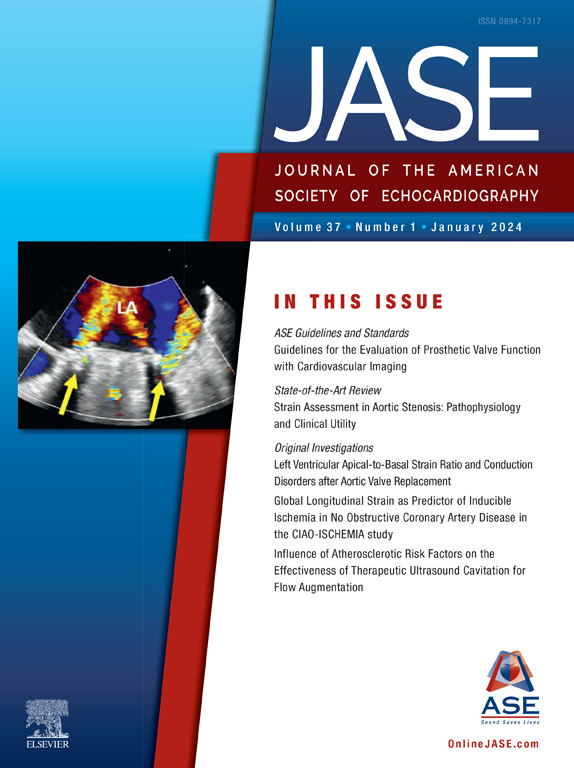Transaortic Flow Rate and Risk Stratification in Moderate Aortic Stenosis
IF 6
2区 医学
Q1 CARDIAC & CARDIOVASCULAR SYSTEMS
Journal of the American Society of Echocardiography
Pub Date : 2025-08-01
DOI:10.1016/j.echo.2025.02.017
引用次数: 0
Abstract
Background
While left ventricular stroke volume (SV) is commonly used to define flow status in patients with aortic valve stenosis (AS), flow rate (FR) serves as a more precise descriptor of blood flow. However, evidence regarding the prognostic significance and determinates of transaortic FR, specifically in patients with a moderate AS, is limited.
Objectives
We aimed to evaluate the association of transaortic FR with outcomes in patients with moderate AS.
Methods
We included 292 outpatients (mean age, 80 ± 9 years; 45% women) with moderate AS (aortic valve area, 1-1.5 cm2) and complete clinical evaluation. Transaortic FR was calculated using the derivation-method (FRder) and validated in 90 random patients in whom transaortic FR was also directly calculated as SV/ejection time (FRdir). The primary study end point was a composite of all-cause mortality and hospitalization for heart failure (HHF).
Results
After median follow-up of 19.3 (interquartile range, 12.3-26.0) months, 73 patients reached the primary end point (22 HHF and 51 deaths). Patients who met the primary end point had a lower transaortic FRder value compared to those not experiencing events (201 ± 47 mL/sec vs 225 ± 48 mL/sec). The transaortic FRder presented excellent correlation with FRdir (R2 = 0.93, P < .0001). The transaortic FRder threshold for excess risk of adverse outcome was approximately 218 mL/sec. Below this value, the risk increased steeply, showing no plateau effect. Several factors were independently associated with transaortic FRder < 218 mL/sec, including female sex, renal insufficiency, previous myocardial infarction, SV index, and at least moderate tricuspid regurgitation (all P < .02). After comprehensive adjustment, transaortic FRder < 218 mL/sec turned out to be independently associated with events (adjusted hazard ratio, 2.17 [95% CI, 1.14-4.12], P = .018).
Conclusions
Transaortic FRder < 218 mL/sec is independently associated with adverse outcomes in moderate AS. Further research is needed to determine whether patients with moderate AS and impaired transaortic FR would benefit from more intensive monitoring or earlier aortic valve replacement.
主动脉瓣流量与中度主动脉瓣狭窄的风险分级
背景:虽然左室卒中容积(SV)通常被用来定义主动脉瓣狭窄(AS)患者的血流状态,但血流速率(FR)是更准确的血流描述符。然而,关于经主动脉FR的预后意义和决定因素的证据,特别是在中度AS患者中,是有限的。目的:我们旨在评估经主动脉FR与中度AS患者预后的关系。方法:纳入292例中度AS(主动脉瓣面积1 ~ 1.5 cm2)门诊患者,平均年龄80±9岁,女性45%。经主动脉FR采用衍生法(FRder)计算,并在90例随机患者中进行验证,其中经主动脉FR也直接计算为卒中容积/射血时间(FRdir)。主要研究终点是全因死亡率和心力衰竭住院(HHF)的综合。结果:中位随访19.3个月(四分位间距12.3-26.0)后,73例患者达到主要终点(22例HHF, 51例死亡)。达到主要终点的患者与未发生事件的患者相比,经主动脉FRder值较低(201±47 mL/s vs 225±48 mL/s)。经主动脉FRder与FRdir呈极好的相关性(R2=0.93),不良结局过度风险的pder阈值约为218 mL/ms。低于此值,风险急剧增加,无平台效应。几个因素与经主动脉FRder独立相关结论:经主动脉FRder
本文章由计算机程序翻译,如有差异,请以英文原文为准。
求助全文
约1分钟内获得全文
求助全文
来源期刊
CiteScore
9.50
自引率
12.30%
发文量
257
审稿时长
66 days
期刊介绍:
The Journal of the American Society of Echocardiography(JASE) brings physicians and sonographers peer-reviewed original investigations and state-of-the-art review articles that cover conventional clinical applications of cardiovascular ultrasound, as well as newer techniques with emerging clinical applications. These include three-dimensional echocardiography, strain and strain rate methods for evaluating cardiac mechanics and interventional applications.

 求助内容:
求助内容: 应助结果提醒方式:
应助结果提醒方式:


